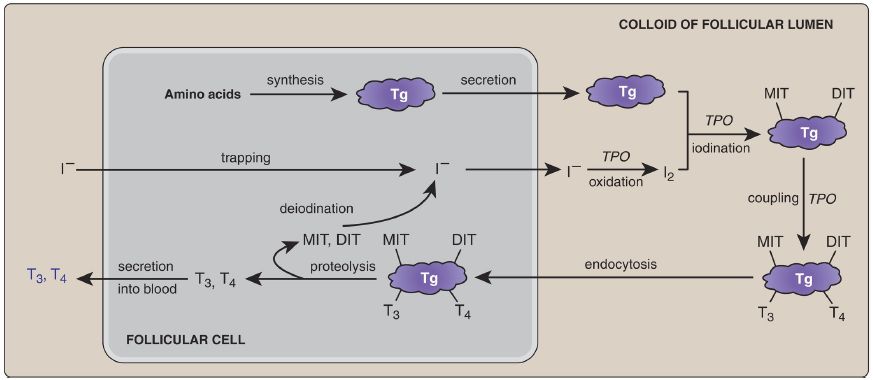
Ultratrace Minerals : Iodine
 المؤلف:
Denise R. Ferrier
المؤلف:
Denise R. Ferrier
 المصدر:
Lippincott Illustrated Reviews: Biochemistry
المصدر:
Lippincott Illustrated Reviews: Biochemistry
 الجزء والصفحة:
الجزء والصفحة:
 19-12-2021
19-12-2021
 1196
1196
Ultratrace Minerals : Iodine
The ultratrace minerals include iodine (I), selenium (Se), and molybdenum (Mo). They are required by adults in amounts <1 mg/day.
Iodine
I is utilized in the synthesis of the thyroid hormones triiodothyronine (T3) and thyroxine (T4) that are required for development, growth, and metabolism. Circulating iodide (I−) is taken up (“trapped”) and concentrated in the epithelial follicular cells of the thyroid gland. It then is sent into the colloid of the follicular lumen where it is oxidized to iodine (I2) by thyroperoxidase (TPO), as shown in Figure 1. TPO then uses I2 to iodinate selected tyrosine residues in thyroglobulin (Tg), forming monoiodinated tyrosine (MIT) and diiodinated tyrosine (DIT), as shown in Figure 2. [Note: Tg is synthesized and secreted into colloid by follicular cells.] The coupling of two DIT on Tg gives T4, whereas coupling one MIT and one DIT gives T3. The iodinated Tg is endocytosed and stored in follicular cells until needed, at which time it is proteolytically digested to release T3 and T4, which are secreted into the circulation (see Fig. 1).
Under normal conditions, ~90% of secreted thyroid hormone is T4 that is carried by transthyretin. In target tissues (for example, the liver and developing brain), T4 is converted to T3 (the more active form) by Secontaining deiodinases. T3 binds to a nuclear receptor that binds DNA at thyroid response elements and functions as a transcription factor. [Note: Thyroid hormone production is controlled by thyrotropin (thyroidstimulating hormone ([TSH]) from the anterior pituitary. TSH secretion is itself controlled by thyrotropin-releasing hormone (TRH) from the hypothalamus.]

Figure 1: Thyroid hormone synthesis. Tg = thyroglobulin; I = iodide; I2 = iodine; TPO = thyroperoxidase; MIT = monoiodinated tyrosine; DIT = diiodinated tyrosine; T3 = triiodothyronine; T4 = thyroxine.

Figure 2: Iodination of thyroglobulin (Tg) with production of MIT and DIT.
1. Hypothyroidism: Underingestion of I can result in goiter (enlargement of the thyroid in response to excessive stimulation by TSH), as shown in Figure 3. More severe deficiency results in hypothyroidism that is characterized by fatigue, weight gain, decreased thermogenesis, and decreased metabolic rate . If hormone deficiency occurs during fetal and infant development (congenital hypothyroidism), irreversible intellectual disability (formerly called “cretinism”), hearing loss, spasticity, and short stature can result. In the United States, dairy products, seafood, and meat are the primary sources of I. The use of iodized salt has greatly reduced dietary I deficiency. [Note: Autoimmune destruction of TPO is a cause of Hashimoto thyroiditis (a primary
hypothyroidism).]

Figure 3: Goiter.
2. Hyperthyroidism: This condition is the result of overproduction of thyroid hormone. Although it can be caused by overingestion of Icontaining supplements (UL = 1.1 g/day for adults), the most common cause of hyperthyroidism is Graves disease, in which an antibody that mimics the effect of TSH is produced, resulting in dysregulated production of thyroid hormone. This can cause nervousness, weight loss, increased perspiration and heart rate, protruding eyes (exophthalmos, Fig. 4), and goiter.

Figure 4: Exophthalmos.
 الاكثر قراءة في الكيمياء الحيوية
الاكثر قراءة في الكيمياء الحيوية
 اخر الاخبار
اخر الاخبار
اخبار العتبة العباسية المقدسة


